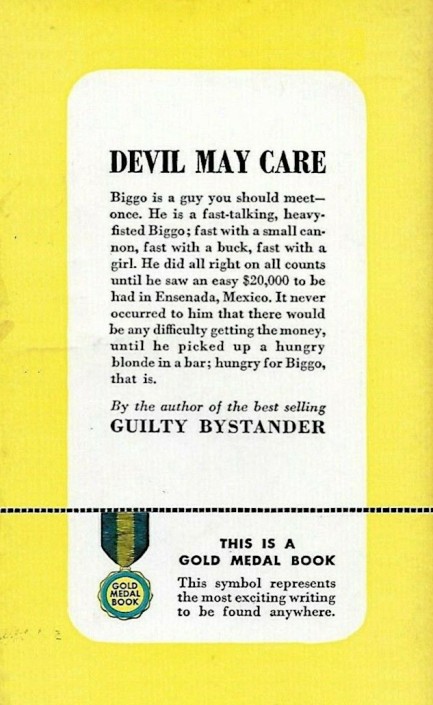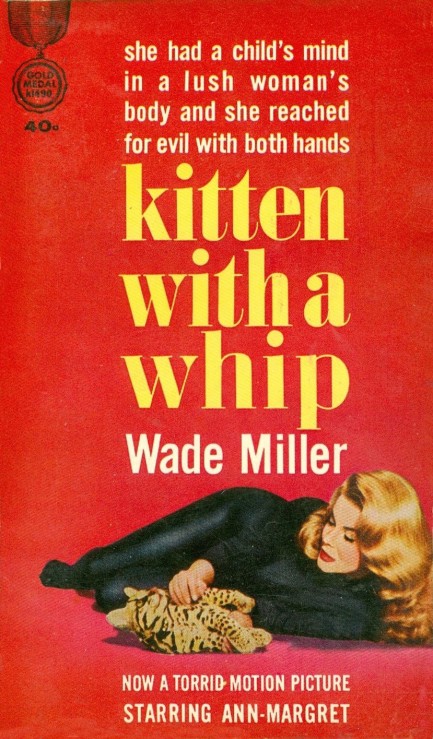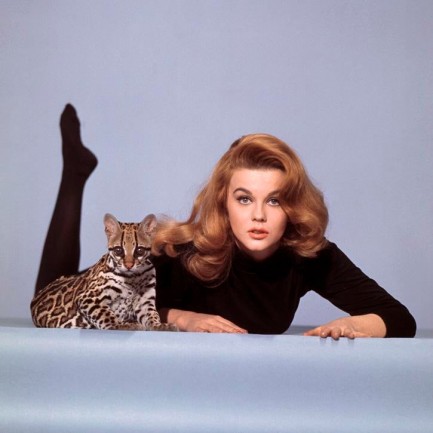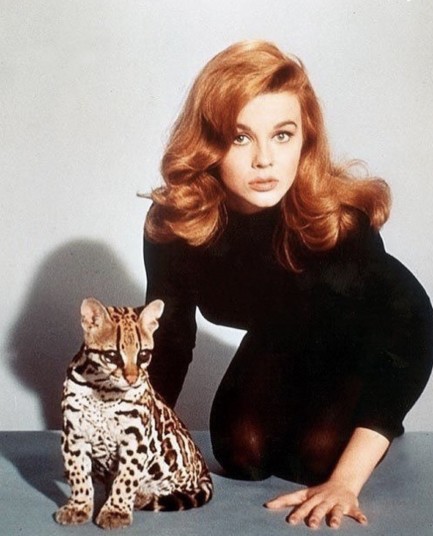 I have a great idea. Since we met by chance on the same discount package tour, let's invite our travel agents to the wedding. 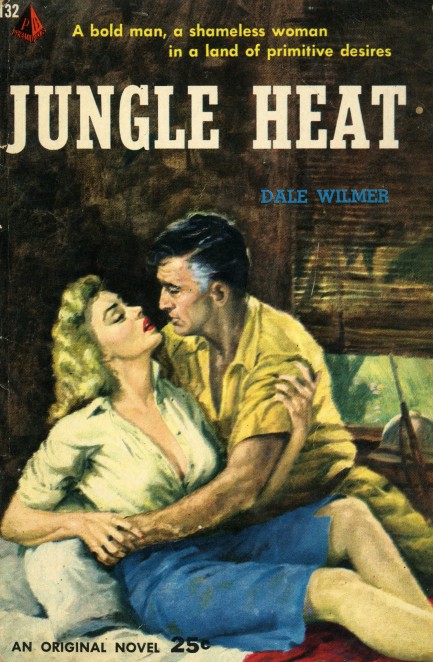
Above: an uncredited cover for Dale Wilmer's 1954 novel Jungle Heat. As we mentioned last year, this was the original edition of the 1960 book of the same title, which was credited to Wade Miller, who was really a shared pseudonym for Bob Wade and Bill Miller. Got all that? You can learn a bit more about the book here.
 That bimbo has no idea she can't get hair dye here. When her roots grow out we'll see if men still think she's so amazing. 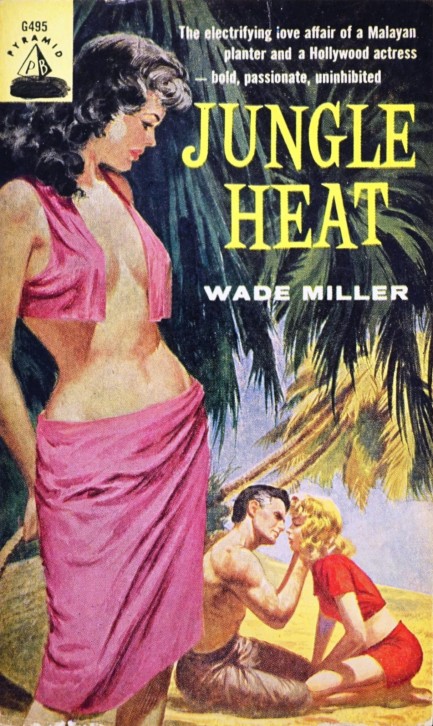
We have other Wade Miller books to read, but we picked up this copy of 1960's Jungle Heat and moved it to the head of the line because the story is set in Malaya (now Malaysia), and the last book we read that the authors (Bob Wade and Bill Miller writing together under a pseudonym) set in an exotic country was phenomenal. Jungle Heat was originally published in 1954 under the name Dale Wilmer, with this reattributed Pyramid edition coming a bit later, and it finds Miller taking on the unexpected challenge of writing in first person from a woman's point-of-view. The lead character is Hollywood b-actress Roxy Powell, who is sent to Malaya with a small crew to shoot background footage for an upcoming jungle adventure. Never mind that a communist revolution is brewing. What Hollywood wants, Hollywood gets.
Plantation boss Llewelyn Kirk, under whose roof Roxy and the crew are residing, is one of those characters who's colonial through-and-through but thinks that because he's been in Malaya for twenty years he isn't an invader and knows what's best for locals. Since the authors agree with this paternalistic sentiment, the narrative is steered—to an almost ludicrous extent—toward Kirk being correct. We won't get into any of it except to say that, generally, anti-communist fiction from the mid-century era was unavoidably propagandist. In this case the authors are basically correct in their regional political analysis, but gloss over important details and whiff on overarching points. For example, there's an interesting scene where a Malayan tells Kirk that he'd heard blacks in America are unjustly killed by whites. Kirk assures him it isn't true. We almost did a spit-take on that one.
Roxy first hates, then by a circuitous path, comes to adore Kirk. She's initially driven by her need for “respect,” which here doesn't mean respect as normally understood, but is instead code for sexual desirability. Because Kirk ignores her, she hates him. Therefore she embarks on a campaign to discover his humanity—i.e. his sexual attraction to her. Even if you didn't know the author, that's when you might suspect a guy—or two—was in the driver seat. Okay, so if the politics take liberties and the justification for romance is male fantasy in disguise, is the book any good? Well, sure. There's a nice jungle setting, a fun Hollywood sidebar, a backdrop of war in which enemies circle ever closer, a traitor hiding in the fold, and love blossoming amid chaos. With all that going for it, the book has to be good. But that said, Wade/Miller definitely wrote better.
 If it helps to persuade you, when you're an old woman you'll look back on even your worst one night stands with nostalgia. 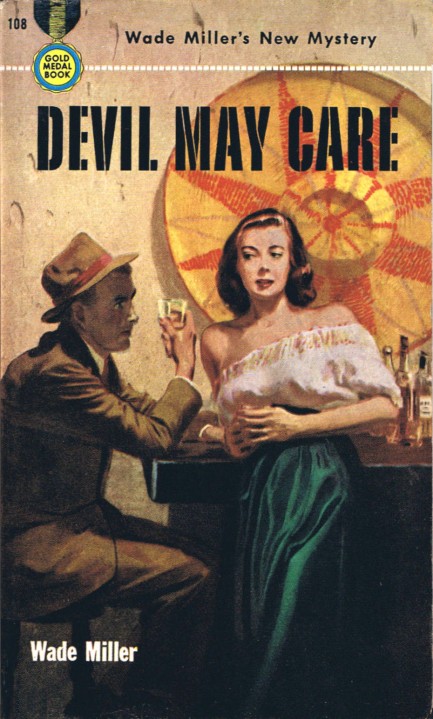
Vintage thrillers and films often used Mexico as a setting, and we very much enjoy when that happens, due to our own numerous trips to the country and the many fond memories they produced. Wade Miller's 1950 novel Devil May Care takes readers to Mexico and does a better job of it than most books we've read. The trip happens when soldier of fortune Biggo Venn is sent to Ensenada on a mission that promises to profit him $10,000. Unfortunately, Biggo's contact turns up murdered, and out of caution he decides the smartest move is to wait for the unknown killer or killers to reveal themselves. He lays low and plays the role of gringo tourist. While doing so he meets up with a hard luck American named Jinny and a beautiful local named Pabla, both of whom are romantic interests, though in Jinny's case it's a love-hate dynamic.
Plenty happens with Jinny and Pabla, but Biggo's most portentous encounter is with fellow soldier of fortune Lew Hardesty, who's not only a rival suitor for both women, but keeps trying to horn in on Biggo's caper. The two eventually get into a vicious fight that settles nothing except that Biggo, who's ten years older, is losing his edge (though he dislocates Hardesty's jaw before the man pushes it back into place and comes at Biggo like a whirlwind). It's a good scene in a fun book. In fact, we think Devil May Care is Wade Miller (a pseudonym for authors Bob Wade and Bill Miller) at his/their best. The story is well paced, exciting, sometimes sad, and often funny. The authors use the rough-edged mercenaries-at-large premise brilliantly, as in this exchange between Biggo and Hardesty:
Biggo growled, “I thought you were in Bolivia.” Just because he had met one of his own kind made the outlook no brighter. Hardesty was a comrade but something less than a friend. He had a knack for showing up where he wasn't wanted.
“I was. Now I'm here.”
“What happened?”
“Have you ever spent a summer in Bolivia? Very hot.”
Biggo understood the old pattern. Hardesty had been on the wrong side, whichever side happened to be losing that year. “Yes, Lew, I was thinking about you only the other night.”
“I love you too.”
“I know that. I remember the time you let me go out after that tiger in the Malay with a jimmied gun.”
Hardesty laughed. “That was a fine joke. Those man-killers are always old tigers, anyway. You've got more teeth than he had. Was that any worse than shipping me that opium in Transjordan? I sat in that mud jail for two months until one of your shells knocked out a wall.”
Biggo laughed in turn. “That was the gunner's fault. He'd promised me a direct hit.”
Much of the dialogue features similar banter, and not just between the soldiers. Hard luck Jinny can quip with the best of them:
Jinny said faintly, “I thought you went to jail.” She looked ready to be sick. She held a cracker halfway to her mouth, forgotten.
“Can't keep a good man down, honey.”
“What's that got to do with you?”
In the end the killers reveal themselves and Biggo—by now seeking revenge as well as a payoff—brings hell directly to their doorstep, or in this case to their yacht in the harbor. The climax brings a surprise or two, and Biggo's fate hinges upon who to trust, and who not to. Devil May Care is a wide-open sort of tale about dangerous men, but its title proves to be contradictory. Biggo pretends not to care about anything except the next mission and the next exotic port of call, but his acceptance of his own aging and his slim hope for retirement and a restful old age matter—in the end—more than anything else. The book has some moments that might make modern readers quail, but all the portrayals and reactions make sense in context. We loved this one.
 You paid the cover charge to get in. Now you have to pay the uncover charge or get out. 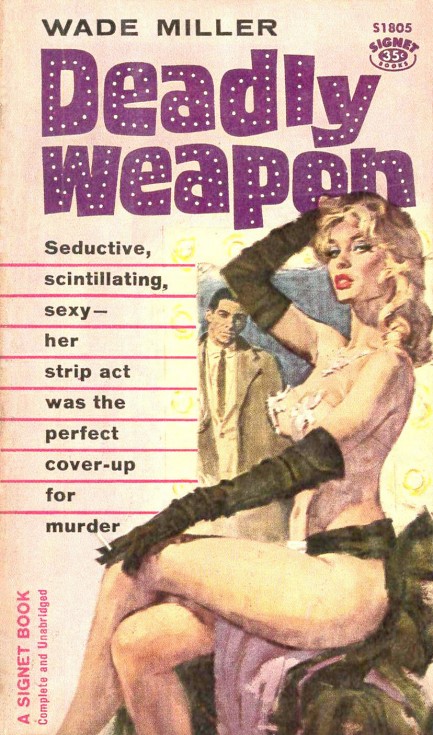
The brush behind this cover for Wade Miller's 1946 debut thriller Deadly Weapon was paperback vet Bob Abbett, and it's one of his better pieces in a portfolio filled with top efforts. The book is good too. It's about an Atlanta detective who drives to San Diego to avenge the death of his partner, and as befits such a concept, features excellent Sam Spade-like repartee between main character Walter James and a local cop named Austin Clapp. Some of the action is centered around a burlesque theatre and its headlining peeler Shasta Lynn, but the deadly weapon isn't a femme fatale, as implied by the art, but Walter James himself. The man is hell on wheels. He even uses his car to ram another auto and its occupants over a cliff. Overall, Deadly Weapon is well written, well paced, and well characterized (if a bit saccharine in the romantic subplot). Wade Miller—who was really Bob Wade and Bill Miller acting as one—started his/their career on a good note with this one.
 If you make enemies they'll always eventually strike back. 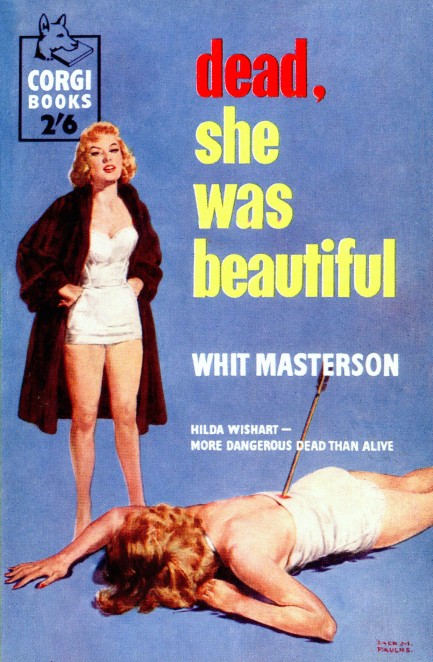
Above, an alternate cover for Whit Masterson's 1956 L.A. mystery Dead, She Was Beautiful. This edition from Corgi Books appeared in 1957, and the art is by Jack M. Faulks, a new name to us. He took an interesting route with this. The art could be depicting the same woman alive and dead (note the blurb: “more dangerous dead than alive”), or it could be depicting two different women of similar appearance. Either works, in terms of the story. Which is to say, yes, a character is shot in the back with an arrow, and yes, that character later turns out to have a twin. Spoiler alert. So you have a cool cover that's more clever than it seems at first. We'll keep an eye out for more from Faulks. And let's all keep an eye out for stray arrows.
 If you could ask the ones who did it we suspect they'd say dying young is overrated. 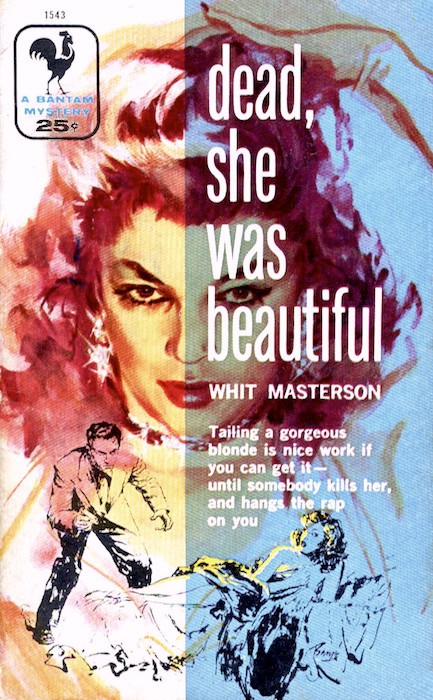
Above, a nice front for Dead, She Was Beautiful by Whit Masterson, aka Wade Miller, who in turn was actually William Miller and Robert Wade writing in tandem. This one has an unusually interesting set-up. A divorce detective is hired by a man to follow his unfaithful wife, and the detective is shocked to discover the woman is his ex-wife. This is in Los Angeles, which immediately raises the question of how such a bizarre coincidence could happen in a city of millions. Well, it isn't a coincidence, which becomes clear when the wife/ex-wife is killed by being shot in the back with an arrow. The cops think the detective may have done it, especially because he hated his ex, so what you get here is the time-honored scenario of a private op who has to solve a crime or take the fall for it. We'd describe this as decent, but nothing special. The cover art is by Barye Phillips, and the copyright is 1956.
 She purrs but only when she's thinking about destroying you. 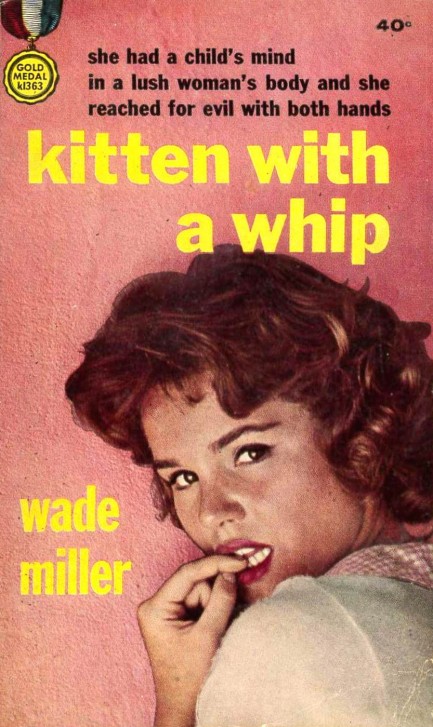
This edition of Wade Miller's iconic sleazer teaser Kitten with a Whip is a rarity and it came from Gold Medal in 1963. There's a moment early in the narrative when the hapless protagonist David turns on a news report about the seventeen-year-old sexpot invader occupying his home. Up until then the girl, whose name is Jody, has been in David's house tormenting him only a few hours, but is threatening to ruin his life with lies that they've been shacked up having a grand old time, or that he tried to rape her. David is paralyzed with fear that his wife, neighbors, and employer will believe her. But in that moment when the entire city is told the girl is a violent psycho who escaped her confinement a mere twelve hours earlier by stabbing a matron, David doesn't realize nobody will believe anything she says—not his employers, not his neighbors, and certainly not his wife—as long as he turns her in then and there. “I woke up, found her in my house, bought her some clothes because she had none, gave her money for a bus out of town—and instead of leaving she decided to stay and blackmail me.” He'd be believed, beyond a doubt. But he never makes the call. So he really deserves everything that happens afterward. But the book is a classic for a reason. It's a fun, crazy read.
 The ultimate hunt is one where the prey can shoot back. 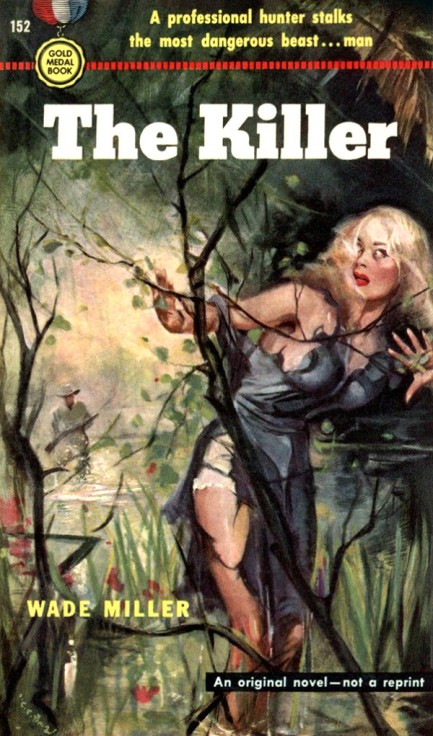 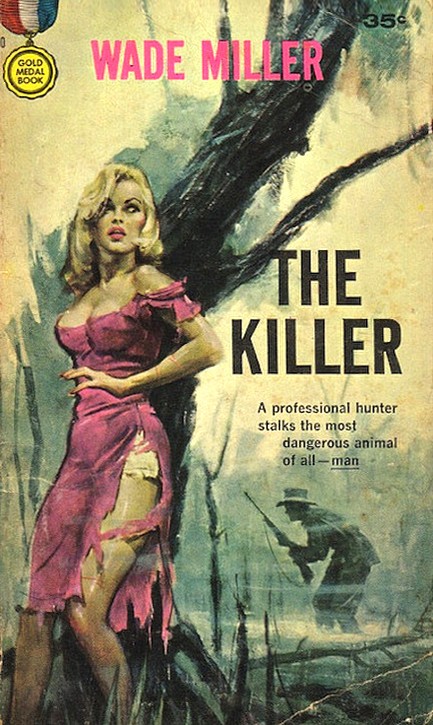
The cover copy perhaps gives the impression Wade Miller's The Killer is about a hunter who goes after human prey for sport, but it's actually about a man who hires a professional big game hunter to track down and kill his son's murderer. While the hero uses his unique skill set to lay a trap or two and make some interesting deductions, the story is a standard thriller. But a pretty good one, set in different locales in the U.S., with a few decent twists and a nice—if somewhat overwrought—love story. Both covers from Gold Medal were compelling, with art by C.C. Beall and an unknown, 1951 and 1958.
 Yes, you’re definitely fabulous, but I said to bring a wetsuit, not a jumpsuit. 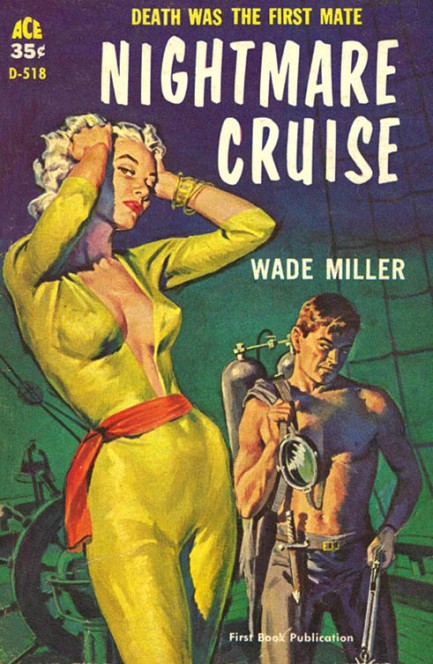
Nightmare Cruise, aka The Sargasso People, was written by Wade Miller, who was not an actual author, but rather a pseudonym for collaborators Robert Wade and Bill Miller. The two also wrote as Will Daemer, Whit Masterson and Dale Wilmer. During the ’40s and ’50s they published about three-dozen novels, including Kitten with a Whip, which became a celebrated piece of camp cinema starring Ann-Margaret. They also wrote Badge of Evil, which was adapted into Orson Welles’ Touch of Evil, a film usually considered the last true noir produced. Miller died prematurely of a heart attack in 1961, but by then the duo’s place in pulp history was assured. Wade continued writing, eventually winning the Private Eye Writers of America’s 1988 Lifetime Achievement Award, and 1998 City of San Diego Local Author Achievement Award. We’ll discuss his noteworthy solo output at a later date.
|
 |

The headlines that mattered yesteryear.
2003—Hope Dies
Film legend Bob Hope dies of pneumonia two months after celebrating his 100th birthday. 1945—Churchill Given the Sack
In spite of admiring Winston Churchill as a great wartime leader, Britons elect
Clement Attlee the nation's new prime minister in a sweeping victory for the Labour Party over the Conservatives. 1952—Evita Peron Dies
Eva Duarte de Peron, aka Evita, wife of the president of the Argentine Republic, dies from cancer at age 33. Evita had brought the working classes into a position of political power never witnessed before, but was hated by the nation's powerful military class. She is lain to rest in Milan, Italy in a secret grave under a nun's name, but is eventually returned to Argentina for reburial beside her husband in 1974. 1943—Mussolini Calls It Quits
Italian dictator Benito Mussolini steps down as head of the armed forces and the government. It soon becomes clear that Il Duce did not relinquish power voluntarily, but was forced to resign after former Fascist colleagues turned against him. He is later installed by Germany as leader of the Italian Social Republic in the north of the country, but is killed by partisans in 1945.
|

|
|

It's easy. We have an uploader that makes it a snap. Use it to submit your art, text, header, and subhead. Your post can be funny, serious, or anything in between, as long as it's vintage pulp. You'll get a byline and experience the fleeting pride of free authorship. We'll edit your post for typos, but the rest is up to you. Click here to give us your best shot.

|
|






